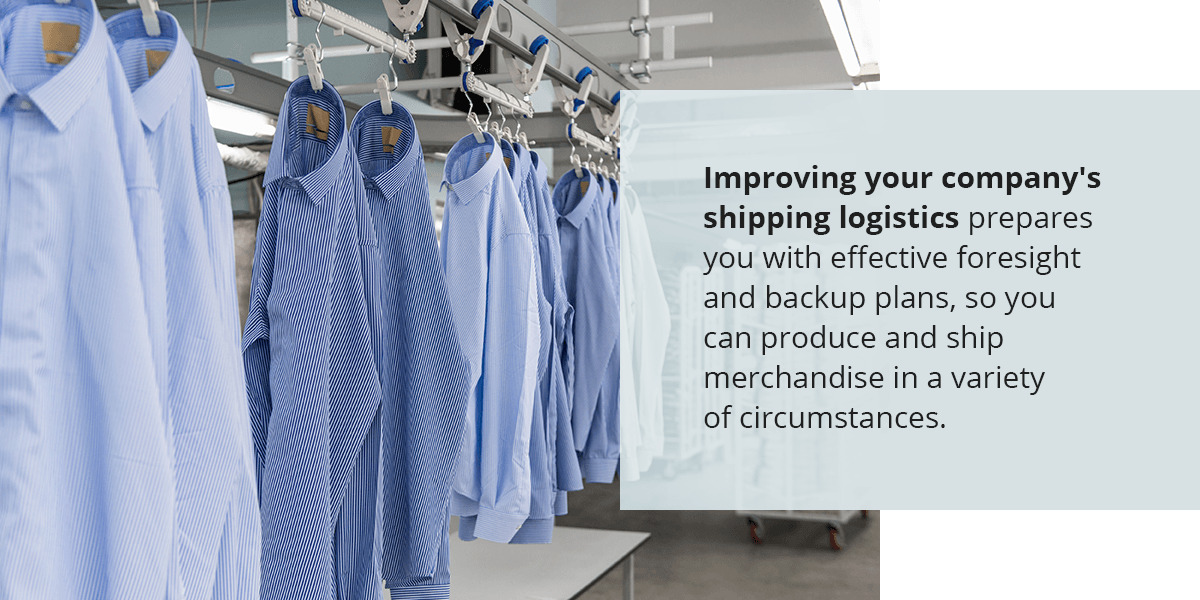Blog
How Improved Logistics Will Grow Your Fashion and Apparel Business

Today’s world heavily depends on fast, reliable shipping. Particularly for the fashion and apparel industry, which includes a complex, multi-step supply chain, you need to know your business’s products will make it to their destinations quickly and efficiently. Fast, organized shipping processes let fashion companies keep up with changing trends and consumer demands.
Just as in any other field, supply chain management in the apparel industry is crucial. Logistics can take your operations one step further, ensuring your planning and shipping procedures are as organized and efficient as possible.
- Supply Chain Logistics Defined
- Clothing and Apparel Supply Chain Overview
- Fashion Industry Supply Chain Issues
- The Importance of Logistics in the Fashion Industry
- Improve Your Logistics With Purolator International
Supply Chain Logistics Defined
Supply chain logistics look at how resources and products are gained and transported, paying particular attention to finding the most effective suppliers and distributors.
Clothing, shoes and accessories have short product life cycles with ever-changing styles that depend on the weather, consumer interests and overarching fashion trends. As the fashion industry grows and becomes increasingly complex, logistical practices such as shipping coordination are more important than ever.
Clothing and Apparel Supply Chain Overview
Distributing garments and apparel is a multifaceted endeavor that relies on multiple distinct steps within the supply chain. Fashion designers are constantly working to stay ahead of the curve, creating new trends for future seasons and determining how to get each of the 52 micro-seasons into stores before the trends shift again.
Creating and distributing a piece of clothing typically follows a process such as:
- Designing items
- Distributing the designs
- Manufacturing the fibers
- Shipping the fibers to the textile manufacturers
- Manufacturing the textiles
- Shipping the textiles to clothing manufacturers
- Manufacturing the clothes
- Shipping the clothes to distribution centers
- Shipping inventory from distribution centers to stores
- Shipping inventory from store to store
- Selling items
- Processing returns, including shipping excess inventory
Clothing suppliers may also ship items from distribution centers directly to consumers.
Most of the above supply chain steps involve shipping. Supply chain logistics are particularly important for the success of the fashion industry. When one step in the supply chain experiences issues or setbacks, the entire process can experience costly delays.
Fashion Industry Supply Chain Issues
Without proper logistics in place, your business could falter in its shipping methods. Some common issues stemming from the fast-paced fashion supply chain include:
- Resource shortages: A supply chain delay at any point in the process stalls the entire operation down the line. If your business experiences an unexpected shortage of resources when making or selling products, you would benefit from an improved logistics strategy.
- Lack of transparency: Due to rising concerns about the ethics of fast fashion, many consumers are demanding supply chain transparency. Shoppers want to know where their clothes are coming from and the conditions under which they’re sourced and manufactured. Brands that withhold this information can face repercussions from shoppers advocating for more ethical fashion practices.
- Inaccurate demand forecasting: Since fashion trends change so often, companies need to keep up with next season’s preparations. New trends can be difficult to predict, as consumer preferences, as well as media and influencer input, can increase or decrease the length of style popularity. To keep up with unexpected demands, businesses often ship excess inventory to stores, which is helpful in some cases, but also often leads to overstocked store inventories that go unsold.
The Importance of Logistics in the Fashion Industry
Logistics can combat many of the above supply chain issues. Improving your company’s shipping logistics prepares you with effective foresight and backup plans, so you can produce and ship merchandise in a variety of circumstances. Using logistics also helps your company define its priorities so you can focus on a few key objectives and do them well.
Once you’re organized and have a clear idea of all the steps in your supply chain and why they happen, you can think critically about each step and find ways to improve your current model. This can include reassessing the need for and uses of stores and distribution centers or determining how you can work best with delivery partners to improve your supply chain performance.
Some practical logistics benefits include:
1. Cost Savings
Use supply chain logistics to save costs throughout your operations. You can do so with steps like these:
- See when you can utilize less-than-truckload (LTL) shipment options to save on shipping.
- Warehouse your apparel closer to customers or stores to reduce transportation costs.
- Analyze your logistics to see if you can reduce labor in your operations, saving on labor costs.
Using logistics in the fashion industry can also benefit customers with improved shipping practices, potentially earning return shoppers and more sales.
2. Flexibility
Shipping logistics give you flexibility at all points in the supply chain. Since you’ll have better control of your operations, you’ll be able to adapt to isolated incidents or industry changes as necessary. Increased flexibility can come from many areas, such as choosing to partner with reliable shipping companies that can ship to a variety of geographic locations.
3. Ability to Monitor Consumer Demands
Increased visibility into your company’s processes lets you more accurately meet inventory needs. Instead of overstocking individual stores, you can use other locations, such as port warehouses, as temporary stocking areas and move inventory to stores as needed.
You can also use advanced analytics to better predict emerging market trends and get a clearer view of what you need to ship, where and when. Better demand knowledge reduces your chances of having too much or too little inventory.
4. Increased Transparency
Improved technology and logistics make keeping track of the many steps in the supply chain easier than ever. Your company can then translate this knowledge to your customers, providing them with readily available information for ethical decision-making. Transparency also helps your business better understand its inventory levels, operations and costs, to make further improvements for the long run.
5. Sustainability Potential
As an increasing number of consumers value sustainable company practices, particularly within the fashion industry, planning and preparation are becoming critical factors in buyer decisions. By helping companies run more efficiently and work better with suppliers, improved logistics also present an opportunity for your company to dedicate more time and resources toward implementing eco-friendly practices. That focus can both honor customer values and decrease your environmental impact.
Improve Your Logistics With Purolator International
The fashion and apparel business is fast-paced and competitive, making shorter shipping times throughout the supply chain crucial to your business’s success. Using logistics puts your company on the map as an efficient, collaborative fashion entity, ensuring your success throughout changing industry standards and consumer demands.
Here at Purolator International, we’re committed to helping your company improve its shipping logistics for all small-freight packages. Whether your product destination is a distribution center, store or end-consumer, we’re your solution for shipping across and between the United States and Canada.
Purolator International is the name you can trust for all your apparel business shipping needs. Contact us today to learn more about our supply chain logistics solutions!

